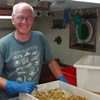General Description
Subhepatic region (area under and between eye and anterolateral tooth) with a low straight ridge. Inner surface of sixth segment (propodus) of male claw (cheliped) hairy only distally, outer surface granular. Walking legs 1 and 2 (pereopod 2-3) with fifth and sixth segment (carpus and propodus) sharply ridged. Up to 2.5 cm wide.
Biology
Sponge crabs carry about with them a piece of living sponge, sea squirt, soft coral or shell that acts as its camouflage. The last legs end in tiny pincers which can only be seen when the sponge is taken off. Because they rely on camouflage and move very little to escape detection by predators, sponge crabs can be difficult to spot under rocks or among algae. Species of Stimdromia are unusual among crabs in that young crabs hatch from the eggs carried by the female and stay with the mother for several weeks. There is no planktonic larval stage.
Habitat
Intertidal, to depths of 120 m.
Soft substrates
Coastal shores
Distribution guide
Australia.
Species Group
Depth
Shore (0-1 m)
Shallow (1-30 m)
Deep ( > 30 m)
Water Column
Max Size
25 mm
Diet
Organic matter
Harmful
Not harmful but a nip from large claws could be painful.
Commercial Species
No
Global Dispersal
Native to Australia
Species Code
MoV 1760
Conservation Status
- DSE Advisory List : Not listed
- EPBC Act 1999 : Not listed
- IUCN Red List : Not listed






